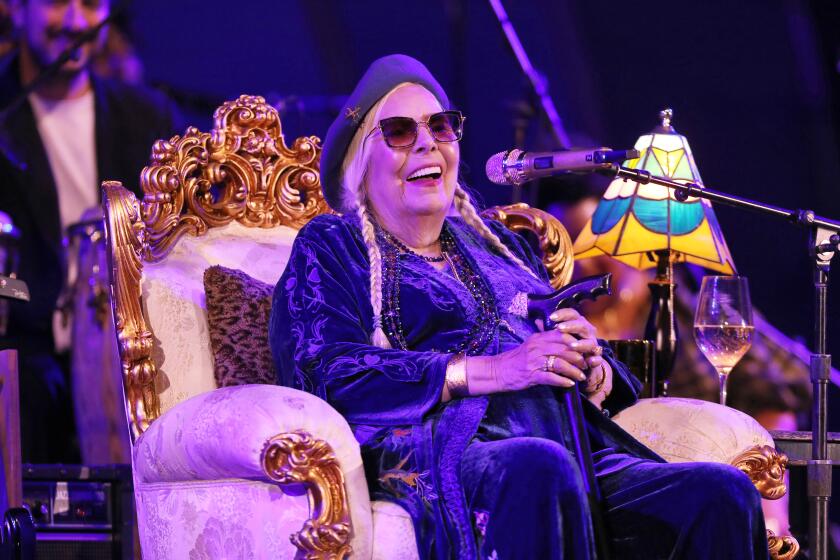MOBY’S LONG PLAYER
Maybe the first time you heard it was in that funky Nordstrom commercial, or while you were sitting through “The Beach” or “Any Given Sunday” at the theater. Or perhaps the first time you heard Moby’s music was during an episode of “Veronica’s Closet” or “The X-Files.”
Wherever it was, odds are you did hear it, placing you among the millions of Americans who have been exposed in the last year to the evocative, ethereal music from Moby’s album “Play,” which marries decades-old blues and gospel with electronica and deejay culture.
You’ve also been exposed to a music industry success story that was written early on, largely without radio, defying the traditional view that airplay is key to making a music star.
It was one year ago this week that “Play” hit stores, loaded with baggage that made it a longshot for any commercial success: The album was on V2 Records, a small independent label, and it was chock-full of songs that defied any traditional radio format. It was also from an artist who, despite critical acclaim, had recently parted ways with Elektra (the major label home of big sellers including Metallica and Busta Rhymes) because he couldn’t click with a mass market.
What a difference a year makes.
“Play” sold 29,000 copies last week in the U.S.--its best single week of sales, which rarely happens a year after an album comes out--and the collection has topped 714,000 in total copies sold.
It continues its climb up the charts, and its best sales may still lie ahead. Worldwide, the album has topped 3 million, and it spent five weeks at No. 1 on the British charts. In recent weeks, Moby has found himself on “The Tonight Show With Jay Leno,” the cover of Spin magazine and the stage of MTV’s college campus concert tour.
More impressive, perhaps, Top 40 strongholds such as KIIS-FM (102.7) in Los Angeles are finally giving spins to such haunting Moby songs as “Porcelain,” which sounds a bit odd sandwiched between Christina Aguilera and the Backstreet Boys.
Surely this was part of a master plan by his manager and label, right?
“No, I never thought that would happen, not back at the beginning,” says Barry Taylor, Moby’s co-manager. “On KIIS? No, I can’t say I would have predicted that. And I can’t say there was master plan, either.
“We just tried to get the music exposed in places where it would seep into the consciousness of people. Film, television, commercials, anywhere that seemed appropriate.”
*
Remarkably, each of the 18 songs on “Play” has been licensed for one of those uses. And that effort will certainly be studied by managers hoping to guide other “problem child” projects to success when most radio programmers give them the cold shoulder.
But that isn’t to say the success of “Play” is a pure marketing creation. Moby has toured intensely and done promotion work for 15 months, including odd but high-profile gigs such as deejay for the MTV Video Music Awards in September. And then there’s the music itself.
“We could have done all the same things with another record, with a different artist, and it might not have worked,” says Richard Sanders, president of New York-based V2 Records. “This one struck a chord. We knew we had to go outside traditional, mainstream channels to find success for it, but from there the music is what made it connect.”
The album also earned two Grammy nominations and bouquets of critical praise, including the nod for best album of 1999 in the Village Voice poll of more than 400 U.S. music critics. It also made Spin’s list of the 20 greatest albums of the decade.
Critical praise often doesn’t translate to sales, however; just ask the Eels, Magnetic Fields or Elliott Smith. Another example is Moby himself: His album “When Everything Is Wrong” was named the best of 1995 by Spin and never made a commercial splash. It failed to reach the threshold of 500,000 copies shipped to the market that would qualify it for gold record status. (Last week, “Play” went platinum, with 1 million copies shipped.)
It was the lack of radio and retail success that prompted Moby to leave Elektra and sign last year with V2 Records, Taylor says. V2 is run by executives with backgrounds in marketing, and that appealed to Taylor because he knew the silver screen and Madison Avenue would be more welcoming to Moby’s sound than pop-minded radio.
Though one track on “Play,” the up-tempo dance song “Bodyrock,” did get interest from alternative radio stations in Atlanta, Chicago and Los Angeles, most of the album was a “difficult sell” to programmers, Sanders says. So, with “Play” languishing at the bottom of Top 200 shortly after its release, V2 could have either given up or looked elsewhere.
No place has been more accommodating to Moby’s atmospheric, rhythmic work than network television, which is always in search of current music that can add zest, drama or pacing to a scene or promo spot. More than a dozen shows have culled music from “Play,” among them “Buffy the Vampire Slayer,” “Dawson’s Creek,” “Judging Amy,” “Party of Five” and “Get Real.”
Some shows, such as “Veronica’s Closet,” include a credit for the music identifying Moby, but what about the rest? How can it help sales of a Moby album when one of his tracks accompanies a promo spot for “Dharma & Greg”? If the music is memorable enough, it sends a parade of people to stores asking for “that song.”
“It happens quite a bit now,” says Gary Arnold, vice president of merchandising for the Best Buy chain. “Creative and current music is being used more and more in advertising, and customers will come in and ask if they can buy it. That has certainly happened with Moby.”
Providing a pop music backdrop for commercials was once controversial--remember the angst created by Nike’s use of the Beatles’ “Revolution”? Now it has become a brisk and accepted business. Sting’s “Desert Rose” has been steadily climbing the pop charts since Jaguar tapped the singer and the song for a new auto commercial, and recently acts ranging from veteran heavyweights the Who to up-and-coming Gomez have their music hyping products.
The crush of music heading into television commercials has changed the mind-set of new acts hoping to follow Moby and break through in electronic and deejay-oriented genres.
At a recent industry showcase for the group Supreme Beings of Leisure, for instance, the Viper Room in West Hollywood was crowded not just by music journalists and radio types but also by advertising account executives and the makers of commercials.
“It’s a different crowd these days,” said a handler for the band, which has been compared in sound to the Sneaker Pimps.
V2 executives are well aware of that new landscape and emphasize efforts to keep their music (from a roster including Mercury Rev, Underworld and Stereophonics) in front of the makers of commercials, Sanders says. It takes time, he says, but “the clock at the major labels ticks a lot quicker. Here we can spend more time on artists and seek out these alternate routes.”
*
Moby’s music has appeared in Nordstrom, LaBatt’s and Nissan ads, and the musician was selected to model for a moody print advertisement for a new line of blue jeans from Calvin Klein. “That was a big one,” Sanders says. “It was about image: This isn’t some techno kid twisting knobs; this is an artist and a personality.”
The Moby ad blitz isn’t over. Now touring Europe, he’s talking with director Oliver Stone about providing a slice of sonic atmosphere for a Motorola commercial for the Chinese market.
The work with Stone would continue “a love affair” between the two that began with the filmmaker’s “On Any Given Sunday,” according to Budd Carr, music supervisor for that film. Carr brought a Moby song to Stone’s attention as a candidate for the soundtrack, and the director told him to get more. By the final cut on the film, five Moby songs were included.
“His music just stands out; there’s something almost three-dimensional about it,” says Carr, who also used Moby while working on the film “Heat.”
“It’s vibrant, it’s not just wallpaper in the background. . . . It adds life to the screen, and directors love that.”
Taylor says another film, “The Beach,” gave “Play” a major consumer-awareness jolt when it used the song “Porcelain” in its trailer and soundtrack. The verdant island setting of the Leonardo DiCaprio vehicle meshed well with the song and, again, helped the music “seep into the consciousness” of audiences, as Taylor put it.
V2 and Taylor reached out to music supervisors in the film community, attended the Sundance Film Festival and included Moby tracks in compilations sent to filmmakers. That led up to a phone call Taylor got last fall: It was Madonna, asking if she could use Moby’s mournful “Why Does My Heart Feel So Bad?” for her film “The Next Best Thing.”
“That’s when I knew we had broken through,” says Taylor, who has managed the New York-based Moby for a decade with Marci Weber.
Film has been good to other electronic artists, most notably Fatboy Slim, and soundtrack albums have become so successful in recent years that they fulfill the role of music sampler that once belonged to radio.
As the U.S. radio industry has been transformed by consolidation in recent years, many observers say the playlists at major market leaders across the country have become more generic and repetitious and high costs have dampened risk-taking among programmers.
“The risk-takers are in film and advertising now,” Carr says. “Every filmmaker wants to discover somebody new . . . and directors today aggressively involve music with their picture. They think about it and care about it more than ever.”
More to Read
The biggest entertainment stories
Get our big stories about Hollywood, film, television, music, arts, culture and more right in your inbox as soon as they publish.
You may occasionally receive promotional content from the Los Angeles Times.










